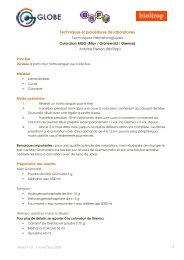Download presentation [1.97 Mb PDF]
Download presentation [1.97 Mb PDF]
Download presentation [1.97 Mb PDF]
You also want an ePaper? Increase the reach of your titles
YUMPU automatically turns print PDFs into web optimized ePapers that Google loves.
Measles protective immunity<br />
Annecy Symposium on<br />
Correlates of Protective Immunity<br />
September 21, 2010<br />
Diane E. Griffin<br />
Johns Hopkins Bloomberg School of Public Health
athogenesis of<br />
measles<br />
Target cells:<br />
Epithelial cells<br />
Endothelial cells<br />
Monocyte/macrophages<br />
T and B lymphocytes<br />
CD4<br />
CD8<br />
10<br />
Days after infection<br />
20
How complete/rapid is clearance?<br />
Studies in Zambian children<br />
• MV cannot be cultured from any site after<br />
the rash has cleared<br />
• However, RT-PCR analysis of<br />
nasopharyngeal washings, urine and<br />
PBMCs shows:<br />
– MV RNA is still detectable after recovery<br />
• 50% positive at some site 1 month after discharge<br />
• 35% positive at 3 months<br />
Permar et al, J Infect Dis 183:532, 2001; Riddell et al, J Clin Virol 39:312, 2007
Current understanding of measles<br />
protective immunity<br />
• Natural measles infection confers lifelong<br />
protection from re-infection<br />
• Parenteral delivery of the live attenuated measles<br />
virus vaccine can also induce long term<br />
protection<br />
• Epidemiologic studies (e.g. Chen et al. JID 162:1036,<br />
1990) show that vaccine-induced protection<br />
correlates with the level of neutralizing antibody:<br />
– >120 mIU/ml: Protection from disease (rash)<br />
– >1052 mIU/ml: Protection from infection (Ab rise)
Measles virus<br />
Neutralizing antibody<br />
Moss & Griffin, Nat Rev Microbiol 4:900, 2006
Rhesus macaque model for measles<br />
rash<br />
intra-tracheal<br />
WT measles virus<br />
Auwaerter et al JID, 1999; Lin et al, unpublished
Why study measles protective<br />
immunity?<br />
• The relative contributions of antibody, T<br />
cells and MV-specific antigen<br />
responses to protection are not known<br />
• Interest in new vaccine approaches to:<br />
– decrease the need for cold chain, needles<br />
and syringes<br />
– increase the ability to deliver 2 doses<br />
through routine programs
Probing measles protective immunity<br />
through studies of vaccinated macaques<br />
• Lessons from old and new vaccines<br />
– formalin-inactivated vaccine<br />
– experimental DNA and virus-vectored vaccines<br />
expressing individual proteins (H and F)<br />
– live attenuated virus delivered by parenteral injection<br />
and by aerosol<br />
• These vaccines provide 4 levels of protection:<br />
– None/enhanced disease<br />
– From rash, but not viremia or infection<br />
– From rash and viremia, but not infection<br />
– From rash, viremia and infection
Immune responses to formalin-inactivated<br />
and live measles virus vaccines<br />
Neutralizing antibody Cytotoxic T cells<br />
Inactivated<br />
vaccine<br />
Live vaccine<br />
Level of protection<br />
1:30<br />
Live vaccine<br />
1:10<br />
Inactivated vaccine<br />
1:15<br />
Polack et al Nat Med 5:629, 1999
Antibody responses to challenge<br />
Antibody amount<br />
DNA<br />
live<br />
inactivated<br />
naive<br />
Antibody avidity<br />
DNA<br />
inactivated<br />
live<br />
naive<br />
Polack et al., Nat Med 9:1209, 2003
Ability of antibody to neutralize MV<br />
infection of different cells<br />
Vero cells (CD46) B95-8 cells (SLAM)<br />
H-DNA inactivated<br />
naive<br />
live<br />
live<br />
naive<br />
H-DNA<br />
inactivated<br />
Polack et al., Nat Med 9:1209, 2003
Enhanced disease after challenge<br />
Lesson: Quantity & quality of Ab is important<br />
Measles Atypical measles<br />
No immunization<br />
Previous immunization with<br />
formalin-inactivated vaccine<br />
Polack et al Nat Med 6:629:1999
New DNA MV vaccines<br />
A. PLG-formulated (Chiron)<br />
Alphavirus promoter (SINCP) - H<br />
• Coating plasmid DNA onto PLG (poly-lactide<br />
glycolide) biodegradable and efficiently<br />
phagocytosed particles<br />
B. Vaxfectin-formulated (Vical)<br />
CMV promoter, codon-optimized - H + F<br />
• Potent adjuvant for DNA vaccines
Immune responses after MV DNA vaccination in<br />
juvenile monkeys<br />
Pan et al, Clin Vaccine Immunol 15:697 & 1214, 2008
Challenge of PLG & Vaxfectin/DNA-vaccinated<br />
monkeys: Viremia<br />
PLG/SINCP-H Vaxfectin/H+F<br />
Pan et al, Clin Vaccine Immunol 15:697 & 1214, 2008
Rashes in PLG-DNAimmunized<br />
monkeys<br />
Control/naive<br />
Low dose, i.d.<br />
(enhanced)<br />
Pan et al, Clin Vaccine Immunol<br />
15: 697, 2008
DNA vaccines: lessons learned<br />
• DNA vaccines expressing H or H+F can<br />
induce protective immunity<br />
• Protection is associated with high titer,<br />
high avidity, durable neutralizing antibody<br />
• Enhancement is associated with shortlived,<br />
low avidity antibody and increased<br />
virus replication
Recombinant Alphavirus replicon-based MV<br />
vaccines (Chiron/Novartis)<br />
• SIN<br />
• Uses the replicon machinery of Sindbis virus with<br />
greatly amplified expression of antigen<br />
• VEE/SIN<br />
• Similar to SIN, but has Venezuelan equine<br />
encephalitis (VEE) backbone that enhances<br />
expression.
Neutralizing antibody responses to<br />
SIN-H particles<br />
Protective level<br />
10 6<br />
Pan et al PNAS 102:11581, 2005<br />
10 8
Viremias after challenge of<br />
SIN-H particle-immunized monkeys<br />
10 6 - rash<br />
10 8 – no rash<br />
naïve - rash<br />
Pan et al, PNAS 102:11581, 2005
unstimulated<br />
H peptides<br />
T cell responses are biphasic<br />
Pan et al, PNAS 102:11581, 2005<br />
IFN-g ELISPOT assay<br />
Days after challenge<br />
viral RNA detected<br />
by qRT-PCR
SIN-H lessons<br />
• Neutralizing antibody alone does not protect<br />
from viremia, but does protect from rash<br />
• ? differential protection from infection of<br />
some cells (e.g. epithelial cells) and not<br />
others (e.g. lymphoid cells)<br />
• there can be late recrudescence of viral RNA
Responses to VEE/SIN-H or H+F vaccination<br />
Antibody responses<br />
T cell responses<br />
VEE/SIN-H and H+F animals protected from rash and viremia<br />
Pan et al., J Virol, 84:3798, 2010
Recrudescence of virus replication after challenge<br />
H-specific T cell responses MV RNA by qRT-PCR<br />
Pan et al., J Virol, 84:3798, 2010
VEE/SIN-H+F lesson<br />
• Protection from viremia and rash does not<br />
necessarily indicate protection from infection<br />
• ? Need to prime immune responses to other<br />
viral antigens
Cellular and humoral immune responses after aqueous<br />
delivery of current vaccine by different routes<br />
Lin et al, unpublished
Priming the T cell response does not protect<br />
from infection or rash<br />
rashes<br />
Lin et al, unpublished
Virus clearance is accelerated when animals<br />
have pre-existing MV-specific memory T cells<br />
Lin et al, unpublished
Conclusions<br />
• Neutralization of lymphoid cell infection by wild type strains of<br />
virus requires high avidity antibody<br />
• T cells do not protect from rash or viremia, but accelerate virus<br />
clearance<br />
• Three levels of protective immunity can be identified:<br />
– protection from disease (rash) – high titer neutralizing antibody<br />
– protection from rash and viremia – Ab + T cells specific for at least H<br />
and F<br />
– protection from rash, viremia and infection – Ab + T cells, may<br />
require T cell functions or MV specificity in addition to H+F<br />
• Further study is needed to<br />
– understand the mechanism and importance of the late appearance<br />
of viral RNA in monkeys protected from disease<br />
• e.g. where is virus, why is there late failure of control?<br />
– understand the immune response to aerosol vaccination
• Paul Auwaerter<br />
• Fernando Polack<br />
• Robert Adams<br />
Acknowledgments<br />
• Chien-Hsiung (Peter)<br />
Pan<br />
• Wen-Hsuan (Wendy)<br />
Lin<br />
Funding from the NIAID and The Bill and Melinda Gates Foundation


![Download presentation [1.97 Mb PDF]](https://img.yumpu.com/6123457/1/500x640/download-presentation-197-mb-pdf.jpg)
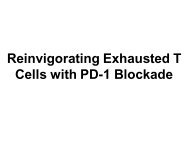
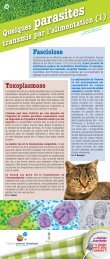

![Download presentation [1.5 Mo PDF] - GLOBE Network](https://img.yumpu.com/46262019/1/190x134/download-presentation-15-mo-pdf-globe-network.jpg?quality=85)
![Download presentation [75.75 Ko PDF] - GLOBE Network](https://img.yumpu.com/41976455/1/190x245/download-presentation-7575-ko-pdf-globe-network.jpg?quality=85)



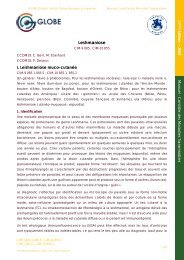
![Download presentation [160.19 Ko PDF] - GLOBE Network](https://img.yumpu.com/36251372/1/190x245/download-presentation-16019-ko-pdf-globe-network.jpg?quality=85)
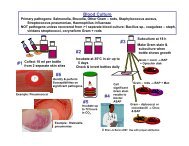
![Presentation [4.79 Mb PDF] - GLOBE Network](https://img.yumpu.com/32872413/1/190x146/presentation-479-mb-pdf-globe-network.jpg?quality=85)

